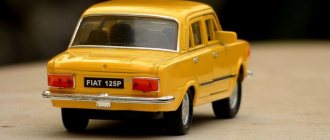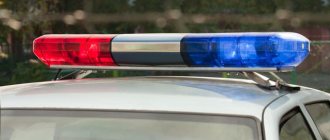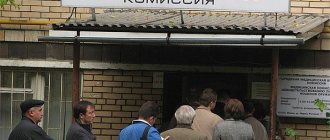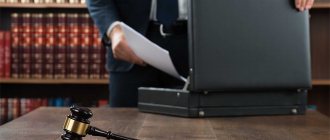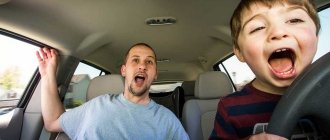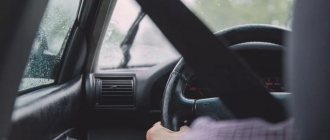Is a medical examination for intoxication after an accident legal?
But let’s talk about everything in order: first, let’s look at the main questions about tests for intoxication, and at the end of the article we will present all the rules of this procedure, since they are very voluminous and meaningful.
So, let's start with the legality of the examination itself. This becomes possible for the executive branch in the form of police officers, thanks to changes that have been made to a number of regulations. These include the Code of Administrative Offenses and the Inspection Rules themselves.
Thus, several years ago, amendments were made to Article 27.12 of the Code of Administrative Offenses, and now its part 1.1 states that a driver in respect of whom a determination has been made under Article 12.24 is subject to referral for examination. But what does some article of the Code of Administrative Offenses have to do with this?
And 12.24 just speaks of the victims. To be more precise, in cases where a driver is suspected of committing a traffic violation or is involved in an accident in which there are injured people, then he is subject to examination. Please note that sending for an examination is not an inspector’s right, but an obligation. That is, the policeman does not decide here, but a simple condition works: are there any victims of the accident? This means that a test for intoxication is mandatory.
A similar requirement is contained in paragraph 2 of the Inspection Rules in Government Decree No. 475.
Can I refuse a medical examination?
This depends on the type of check, and there can be 2 of them:
- examination for alcohol intoxication (hereinafter referred to as “OSAO”),
- medical examination for intoxication (hereinafter referred to as “MOSO”).
For now, remember these 2 types of tests. They are radically different, although they are closely interrelated. Below we will talk more about their differences.
But the main thing you should know is: you have every right to refuse to be tested for alcohol (“blowing” on the road in the inspector’s car), and you will not face any consequences for this. But if you refuse a medical examination, punishment will follow - and quite severely. And the refusal of CILUMV itself is one of the direct grounds for referral for a medical examination.
Does this threaten deprivation of rights or a fine?
Both. For refusal of a medical examination in 2021, a separate standard of responsibility is provided - Part 1 of Article 12.26, which threatens 2 penalties simultaneously:
- a fine of 30,000 rubles for refusing a medical examination,
- deprivation of rights for a period of 1.5 to 2 years (by decision of the judge).
This punishment is imposed by a court (magistrate) on the basis of a protocol of a traffic police officer, drawn up in accordance with all the rules after the driver has been removed from driving, the involvement of 2 witnesses or the production of a video recording, as well as a preliminary offer to undergo an examination for intoxication. Here is a typical example from judicial practice regarding deprivation for refusal of a medical examination with no less typical arguments for the defense of the accused driver.
Please also note that the penalty for refusal is the same as the penalty if intoxication is properly established. Part 1 of Article 12.8 of the Code of Administrative Offenses of the Russian Federation provides for the same fine and the same period of deprivation of rights for driving while intoxicated (including road accidents while intoxicated).
The only difference is that in case of deprivation for refusal of a medical examination, there cannot be an additional punishment for handing over the steering wheel to a drunk person, since intoxication will not be established legally.
Where do they make it?
Each inspection location has its own nuances.
On the spot
At the scene of detection of an offense, the study is carried out using a breathalyzer - a special device that examines the air exhaled by the driver.
This type of examination can only determine the presence of alcohol in the driver’s body, and is absolutely unsuitable for detecting drug intoxication.
For testing, you can only use a certified breathalyzer that has passed the next verification. Documents on certification and verification must be with the traffic police inspector and presented upon request of the driver.
In addition to the breathalyzer, it is necessary to have disposable “tubes” (popularly called) through which air enters the device.
The results of the test are recorded in writing in a special document - an act, the form of which is established by Appendix 2 to the Order of the Ministry of Health.
A driver is considered to be intoxicated if the device shows more than 0.16 ml of alcohol in 1 liter of exhaled air, which corresponds to 0.3 ppm.
The established deviations from zero values are aimed at eliminating the error of the measurements, and in no case at all at allowing the consumption of alcohol during or before the operation of motor vehicles.
An examination at the scene of detection of signs of an administrative offense must be carried out in the presence of two witnesses or using video recording of the process.
If the driver’s examination is carried out in the presence of witnesses, then the full name, residential address and signatures of the witnesses must be reflected in the act recording the results of the examination.
At the traffic police
A test for the presence of alcohol in the driver’s body can also be carried out at the post or at the nearest traffic police department.
As in the previous case, exhaled air is subject to examination, and a breathalyzer with disposable “tubes” is used for testing.
The test results are recorded in the report.
In the hospital
The examination can be carried out in a stationary medical center and a mobile laboratory.
Laboratories equipped on the basis of vehicles are subject to certain requirements (Order of the Ministry of Health):
- the height of the laboratory interior must be at least 1.85 m;
- there must be a rubber track in the cabin for testing;
- Interior lighting must be at least 100 lux;
- the laboratory must freely accommodate two people (a doctor and a patient), as well as various equipment for conducting research, including express tests.
In a medical facility (mobile laboratory), an examination of a driver suspected of intoxication can be carried out:
- a breathalyzer, that is, by determining the amount of alcohol in exhaled air;
- by conducting medical tests on the driver's urine or blood.
The breathalyzer test is performed two times:
- immediately upon the driver’s arrival at the medical facility;
- 15 - 20 minutes after the first study.
If the test results differ significantly or do not show the presence of alcohol in the exhaled air, then the driver is sent for testing.
Urine is usually used to test the driver for alcohol intoxication, and blood is used to test for the presence of drugs.
The presence of alcohol in the blood or urine in an amount of more than 0.3 ppm indicates that the driver is intoxicated.
The report on passing a medical examination in a medical institution is drawn up by the doctor on duty, who may be a paramedic, therapist or directly a narcologist. The presence of witnesses and video recording are not required in this situation.
The deprivation of rights for alcohol intoxication in 2021 for the first time is described in the article: deprivation of rights for alcohol intoxication for the first time.
Read about the amnesty for those deprived of their rights for alcohol intoxication in 2021 here.
Is this an alcohol or drug test?
Above we indicated that there are 2 types of examination. It is precisely the target verification that distinguishes them.
- CVUIL is carried out directly on the road by “purging” the breathalyzer (sometimes, if the inspector does not have the device with him, then you may be taken to the nearest post). And this check is carried out only for the purpose of establishing alcohol intoxication - exhaled air vapors are examined to determine the percentage of ethyl alcohol in them.
- MOSO is a full-fledged study in a medical institution. Here, too, a breath sample is first taken to analyze the alcohol content. But as an additional procedure - chemical and toxicological studies. They are carried out to determine the content of narcotic drugs in the driver’s body. The collection can be either urine (carried out in all standard cases) or blood (blood is taken only if the driver is unconscious after an accident and, accordingly, will not be able to “give out” urine for testing).
The intoxication test is carried out with the consent of the driver. A medical examination is carried out only if one of 3 grounds is present:
- if the driver refuses to be tested for alcohol,
- if the device shows intoxication during the CIAU, but the driver does not agree with the results of the “breathalyzer”,
- if the breathalyzer shows zero, but the traffic police officer believes that the driver is still drunk (for example, due to drug use).
As you can see, the medical examination in any case should be preceded by a “purge” on the road. If the inspector did not offer you a compulsory insurance but immediately sent you to the MOSO, then this is illegal, since the procedure for collecting evidence was violated. This is exactly what the Supreme Court thinks, which in its Resolution of the Plenum No. 20 (paragraph 11) indicated that this is illegal, except in cases where the driver is unconscious, and it is not possible to “blow out” him on the spot. And in paragraph 23 of the same judicial practice it is stated that evidence obtained in violation of the law is not subject to consideration.
How to undergo an initial examination
It is worth noting that the breathalyzer is equipped with a disposable mouthpiece, which the inspector must print out in front of you and install it on the disconnected device. The alcohol meter turns on only after the mouthpiece is fully attached to it. When turned on correctly, a test is performed to check the air and analyze it.
Next, you should wait for the moment when a message about the absence of alcohol appears on the device screen, and if you are sure that you did not drink, and the display shows even the minimum level of alcohol, then you have the right to demand that the mouthpiece on the device be replaced or ask to be directed to re-examination in the presence of a medical professional.
When you are then given the opportunity to fill out a report, be sure to indicate that you do not agree with the conclusions of the police inspector and have not consumed alcohol in the last 24 hours. It is imperative to indicate the date and time of filling out the document so that the police officer cannot correct them in his own interests.
If during the test the alcohol exceeded the level of 0.16 mg per liter, then you are subject to punishment in the form of one or another administrative liability. But if the level shows below 0.3 ppm, then you are considered sober and you must be checked additionally by a doctor.
It is advisable to request a re-examination at the clinic rather than breathing into a tube again. During the first examination, the inspector is obliged to give you a copy of the printout about the examination, do not forget to pick it up.
Is any road accident sent for testing?
In general, they can send it in case of any incident. The 2021 legislation only states that under certain conditions this procedure is mandatory.
Is an examination required if there is an accident without injuries?
No. But this is not excluded. The fact is that the same part 1.1 of Article 27.12 indicates that a person is subject to testing for alcohol or drug intoxication if there are reasonable grounds to believe that he is drunk.
Thus, even if there was an accident without injuries and even if there was no accident, and you were stopped by a traffic police officer and assumed that you were drunk, then he has the right to check you properly for this.
But the inspector’s assumptions must be supported by clearly specified criteria and conditions. All of them are described in paragraph 3 of PPRF No. 475, and they include 5 grounds:
- smell of alcohol from the driver's breath,
- speech disorders,
- unstable posture,
- if your facial skin has changed color dramatically,
- if the behavior does not correspond to the situation.
And here lies almost any opportunity to check the driver for alcohol intoxication. If the first 4 conditions, which are quite clear, do not fit the situation, then the fifth is quite universal. Did you look at the inspector wrong? Stumbled while getting out of the car? These are all reasons to indicate that the behavior is not appropriate for the situation. Moreover, in the protocol the employee is not obliged to specify exactly how your behavior was inconsistent and how it was expressed. Although later in court, when considering the case, the judge may question the employee on this issue.
But in any case, in any situation on the road, even not just after any accident, a traffic police officer has the right to check the driver for intoxication.
If there are any injured and/or dead?
And this is where the main difference from an accident without casualties lies. As we mentioned above, if there is harm to health, examination becomes mandatory. And this does not depend on the inspector's decision.
At the same time, first the employee who arrives at such an accident is obliged to carry out a “purge” in the breathalyzer, and only after the driver refuses it, or disagrees with the results of the driver or the inspector himself, offer to go to a medical facility for a full check. If the latter refuses, the motorist will already face deprivation of rights for a long period and a large fine.
How to get your license back if you refuse an examination
As mentioned earlier, it is highly not recommended, due to some of its principles, to refuse the alcohol testing procedure. If you don’t want to be checked by an inspector, ask for a doctor, but do not refuse the procedure completely, otherwise the law will subsequently not be on your side.
And if you cannot find a good and experienced lawyer to resolve this case in order to regain the right to drive your car, the case may be completely unsuccessful for you.
It is advisable to contact a specialized auto lawyer who is versed in all the nuances of such cases. The reasons for a positive outcome may be:
- presence of errors made by the inspector when filling out the protocol. If a lawyer is savvy in his field, he will easily use them to resolve the situation in your favor;
- in addition, even in your absence, he will help you correctly file a petition for the abolition of administrative liability and punishment in the form of deprivation of rights so that higher authorities make a positive decision.
If you are found guilty and a report on the seizure of the car is drawn up, then it is sent to the impound lot. To avoid seizure, you should hand over the car in advance to the person included in the insurance document.
According to statistics for last year, most often the judicial authorities refused to withdraw the right to drive a car if the protocols were drawn up by traffic police inspectors with errors. This applies to protocols such as:
- a ban on driving;
- about referral for a medical examination;
- about the seizure of the vehicle.
Also remember that another key to your success in such a matter is that before you sign a particular document, you should carefully study it. This way you will protect yourself from unnecessary problems, and even more so from legal proceedings.
Who should be checked?
Only the driver is subject to referral for examination - and only the driver in respect of whom a determination has been drawn up under Article 12.24 of the Code of Administrative Offenses of the Russian Federation.
But no, and the second driver can be “blown away” in an accident. But for this you will already need your own reasons (sufficient to assume that he is drunk). And only for the alleged culprit of an accident there is only one reason for verification - the presence of victims and, as a consequence, determinations under 12.24 of the Code of Administrative Offenses.
What are the inspection rules for road accidents in 2021?
In general, if there is a suspicion that the driver is drunk, any check should begin with a suspension protocol - this is one of the main rules of this procedure. However, in the event of an accident with victims, the driver is not supposed to be removed from driving the car - there is no such obligation in the Code of Administrative Offenses of the Russian Federation.
However, there are quite voluminous and complex rules, and the procedure for the inspector consists of many points. In general, collecting evidence specifically for drunk driving offenses is one of the most procedurally difficult.
Let's look at the correct order of this procedure one by one.
- The inspector arrives when called to an accident involving injuries. In this case, he must draw up a ruling on an administrative offense, thereby launching an investigation procedure under Article 12.24 of the Code of Administrative Offenses of the Russian Federation, which contains penalties for causing harm to the health of other people. That is, the driver has already violated something (for example, drove through a red traffic light), which caused the accident. But, if there are victims, there will be not only a fine for the prohibitory signal, but also for causing harm to health.
- Article 27.12 provides that if the specified determination is available, the one in respect of whom it is drawn up must undergo an examination procedure.
- Then the traffic police officer suggests that the driver take a breather. In this case, a certified device must be used, it must have a verification certificate, and it must produce the result on paper (clause 5 of the Inspection Rules).
- And before starting the inspection, the employee must tell the driver about the CILUMV procedure, as well as show the integrity of the verifier’s mark and indicate the presence of a verification certificate (paragraph 6).
- Based on the results of the compulsory insurance, an inspection report is drawn up. If the device shows that your exhalation contains 0.16 milligrams per liter of air or more, then the report indicates that a state of intoxication has been established. And a paper printout from the “breathalyzer” is attached to this document (points 7-9).
- If the driver does not agree with the results of the examination for alcohol intoxication, or if the traffic police officer does not agree with them, and also if the driver refuses to undergo this procedure, then the latter is subject to referral for a medical examination (clause 10).
- In this case, an appropriate protocol must be drawn up, which indicates the basis for the MOSO, the place and time of the referral, and the protocol itself is signed by the inspector and the driver (Article 27.12.1 of the Code of Administrative Offenses of the Russian Federation).
- Next, the driver is taken to a medical facility. In very rare cases in 2021 there may be mobile laboratories that can be at the scene of an accident.
- A new legal act is already beginning to take effect here - Order No. 933N on the MOCO Rules. At the facility, a sample of the driver’s air is taken to analyze the alcohol content in the breath. If the exhalation showed 0.16 mg/liter or more, then a second sample is taken 15 minutes apart. By decision of the doctor, the driver can be tested as part of a chemical toxicological test (CTS) - this is the only test that detects drugs in the body. In this case, you will need to donate urine into a jar. But, if the driver is unconscious, they will take blood.
- All inspection results are entered into a medical examination report (and this is a separate document - not the same report that was drawn up under the CILUMV).
- If the exhalation contains 0.16 milligrams of alcohol per liter of air, or if narcotic substances are found within the framework of chemical testing, as well as if there are clinical signs of intoxication, the examination report says “a state of intoxication has been established.” Please note that in order to be subject to deprivation of rights, there must be clinical signs, and not just substances and/or alcohol must be found (clause 17 of Order No. 933N).
There are also a large number of requirements for medical examination, including licensing requirements for medical institutions and specialists. All of them are listed in the said Order.
Important note!
- This article describes the basic principles of how legislation works. Meanwhile, in judicial practice everything depends on specific circumstances.
- In 96% of all cases there are subtleties that can affect the outcome of the entire case.
- Therefore, we recommend entrusting the matter to professionals who will study your business and select the right winning strategy.
The TonkostiDTP website employs professional road accident lawyers with experience in all major types of disputes (MTPL, guilt, administrative penalties).
Ask a lawyer
or get a free consultation by calling the hotline: 8.
How can you be dissuaded from being examined?
Of course, dishonest inspectors are not interested in you undergoing a second examination, especially if they do not have “their” person in the clinic and they used certain tricks during the test. Therefore, in such cases, such an inspector will use all possible means to dissuade you from conducting a re-examination by a medical specialist.
Thus, according to the law, if you refuse an initial examination using a breathalyzer, you are obliged to demand that it be carried out in a medical institution, but not refuse to conduct it completely.
To deceive you and issue a fine, a traffic police officer can perform the following actions, be vigilant:
- So, you were tested through a breathalyzer, and it showed a negative result, that you are sober. After this, the traffic police officer gives you a document stating that you refuse the procedure at the medical institution and a second check is not needed. If he does this, then it’s better to waste your time and go through the test again. Otherwise, you will then not prove the fact that there was a check initially, or he will provide incorrect results;
- for some reason you do not want the examination to be carried out by the inspector himself, and you demand that it be carried out by a medical worker in a specialized institution. However, he formalizes such a completely legal requirement as a refusal to undergo an examination. Such a traffic inspector works dishonestly, remember this;
- Make sure that after conducting the examination on site or in the clinic, the inspector fills out a report and you are required to sign it. Otherwise, he will indicate that you refused to undergo an alcohol test and sign the protocol. It is advisable to photograph or video the process of filling out the protocol with a mobile phone.
If you are sober and do not want to be deceived by a law enforcement official, remember the following:
- when you are confused by the results of an examination in a medical institution, within two hours from the moment it was completed, take it again in a paid clinic on an independent basis;
- be sure to save all the information and witnesses and their contacts who can confirm the fact that you had no signs of intoxication at the time of the meeting with the traffic police inspector;
- do not forget to demand from him that all your comments be included in the protocol, including your complaints against him;
- To sign, you must be given one copy of the event protocol.
What is the procedure if employees break the rules?
The main thing we can recommend when testing for intoxication is that despite the presence of witnesses or video recordings from traffic police officers, always film the video using your own devices. It is highly desirable that this be a continuous recording from the moment of conversation with inspectors on the road until leaving the medical facility.
The second main rule is that any violation of these procedures entails the opportunity to avoid deprivation of rights. Because, as we indicated above, violations in the collection of evidence in administrative law make this evidence illegal and inadmissible for consideration in court.

